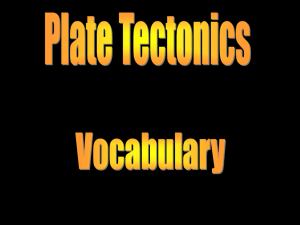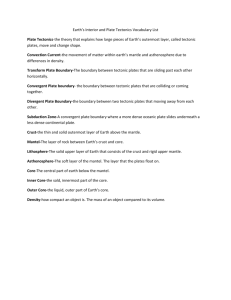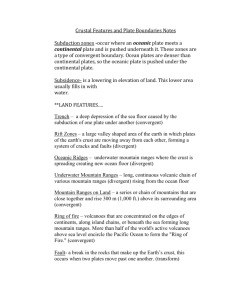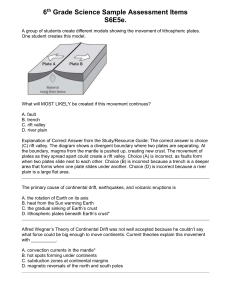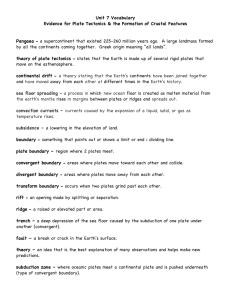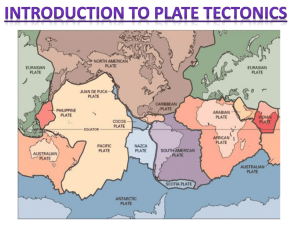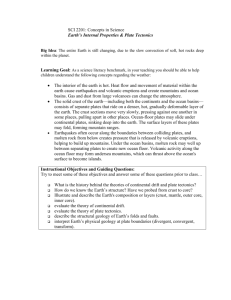The Theory of Tectonic Plates
advertisement
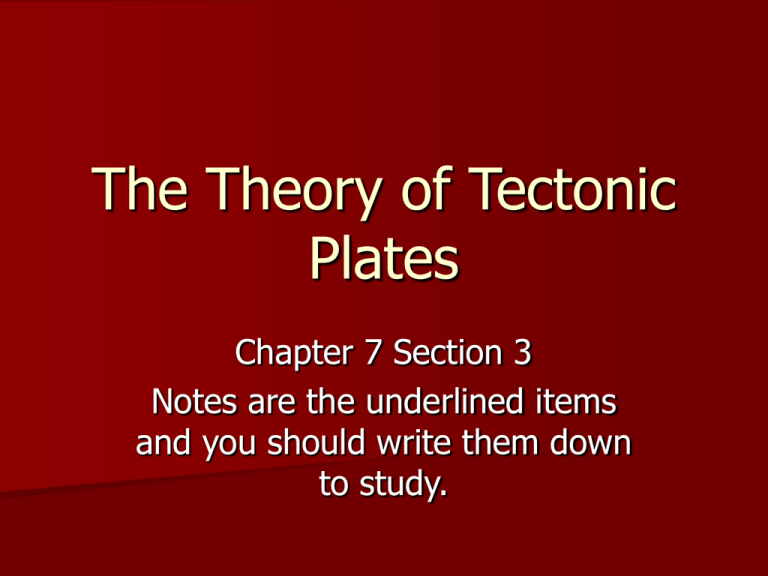
The Theory of Tectonic Plates Chapter 7 Section 3 Notes are the underlined items and you should write them down to study. Tectonic Plates—the lithospheric plates The Theory of Plate Tectonics The Earth’s lithosphere (crust and upper mantle) is divided into tectonic plates. These plates move on top of the asthenosphere (upper mantle). Plate tectonic theory explains how the Earth’s crust is divided into plates & they move around on the asthenosphere. Why do the plates move? We know that these plates move in different ways: A. ridge push B. slab pull C. convection Causes of Plate Movement Described A. Ridge push: plates are pushed away from the mid-ocean ridge B. Slab pull: a tectonic plate is sucked down & under another plate C. Convection: hot magma deep from within the Earth rises, cools, then sinks. – The number 1 reason for plate movement. – This movement of magma causes plates to move. Reasons for plate movement ( see p. 204 in textbook) Ridge push occurring at the mid-ocean ridge Subduction zone Subduction zone Tectonic Plate Boundaries A boundary is a place where tectonic plates touch. There are 3 types of tectonic plate boundaries: – Convergent (together) – Divergent (apart) – Transform (sliding past one another) The numbers on the map represent the rate at which plates are moving in centimeters. Convergent Boundary When two plates collide, or move toward each other, the boundary is called convergent. There are 3 types of convergent boundaries, depending on what type of crust comes together: – Continental-continental – Continental-oceanic – Oceanic-oceanic Convergent Boundary: Continental-Continental The two continental plates come together and either: – Buckle, thicken, or push continental crust upward, making mountains on land or under sea (ocean ridges) Convergent Boundary: Continental-Oceanic Dense oceanic crust sinks below the continental crust & sinks into the asthenosphere—this is a subduction zone. – Sub means below (submarine, subway). Old ocean crust is pushed below the asthenosphere at the subduction zones, getting melted & thus recycled. Convergent Boundary: Oceanic-Oceanic One oceanic plate sinks below the other, creating a subduction zone, where the plate is melted & recycled into molten magma. Divergent Boundary Two tectonic plates move away from each other: – Either ocean & ocean plates or continental & continental plates. Sea floor spreading occurs when a divergent boundary occurs at a mid-ocean ridge & is where new crust is made. As the plates move apart, magma rises to fill the gaps. The magma is cooled and forms new ocean Divergent Boundary The volcanic country of Iceland, which straddles the Mid-Atlantic Ridge, offers scientists a natural laboratory for studying on land the processes also occurring along the submerged parts of a spreading ridge. Iceland is splitting along the spreading center between the North American and Eurasian Plates, as North America moves westward relative to Eurasia. Divergent Boundary On-land exposure of the Mid-Atlantic Ridge in Iceland. Sea Floor Spreading Transform Boundary Two tectonic plates move past one another. – Can be an ocean & an ocean plate or a continental & a continental plate Their edges are jagged and irregular. As they grind together and jerk, they slide past each other creating tsunamis & earthquakes. Tracking Tectonic Plate Movement Plates move very slowly—only a few centimeters a year. – N. Am. Plate moves 4 cm each yr away from African plate. Calculate the number of years that it took New York and the west coast of Africa to reach their current locations, 676,000,000 cm apart, if the sea floor is spreading an average of 4 cm a year. Tracking Plate Movement GPS, Global Positioning System, measures the rate of movement. – Radio signals beam continuously from satellites to the Earth. – By recording the time it takes for the ground station to move a given distance, scientists can measure the speed at which plates move. Make a chart that identifies the type of boundaries, the type of plates that can be at each, and what results at these boundaries. Boundary Type of Plate Results Transform Ocean/ocean or continent/continent Earthquakes & tsunamis Divergent Convergent What your chart should look like completed: Boundary Type of Plate Results Transform Ocean/ocean or continent/continent Earthquakes & tsunamis Divergent Ocean/ocean Makes new crust @ mid-ocean ridges continent/continent faults; earthquakes Continent/continent Makes mountains; ocean ridges (under water mtns) Continent/ocean or ocean/ocean Makes subduction zones which recycle Earth’s crust Convergent Practice Naming Boundaries Refer back to Figure 4 on page 194 to locate examples of different types of tectonic plate boundaries. Identify the types of boundaries found on p. 194: – Locate at least one type of convergent boundary: Continental/continental collide, continental/oceanic collide, or oceanic/oceanic collide – Locate at least one divergent boundary: where ocean ridges move apart – Locate at least one transform boundary: where two plates slide past each other
